Are you an author with a captivating children's story to tell? Or perhaps, you have a burning desire to stimulate young minds with fascinating tales and life lessons?
While the creative process of self-publishing is undoubtedly thrilling, it does beg the question - how much does it cost to self-publish a children's book? In this detailed guide, we will break down the cost associated with transforming your story from a manuscript into a beautifully written book.
Publishing a children's picture book involves costs like editing, illustration, design, printing, and distribution, which vary based on factors such as illustration complexity and printing method, including the marketing budget. Researching industry rates and creating a detailed budget are essential for a successful launch in the publishing process. We'll make this easier for you, so check the detailed cost breakdown below with us.
ExWhyZed would print your children's book for $180 for 100 copies on A4 softback with wire stitched and perfect bound. This means one book would cost you about $1.8. Mass production of books would be more cost effective as you're printing more while paying less. To get a personalized quote on how much it would cost to print a children's book, get in touch with us now!
Experienced copy editors with years of experience ensure impeccable sentence structure, grammar, and overall coherence. Investing in developmental editing guarantees a polished final product that resonates with young readers. Utilizing NLP tools or hiring professional editors on platforms like Reedsy can streamline this phase.
Authors should allocate a portion of their budget to guarantee a high-quality manuscript, which is vital for a successful book launch. Remember, the effort put into editing and proofreading reflects the book's overall professionalism.
Illustration and design costs can vary a lot depending on the complexity of the artwork and the illustrator’s experience. But one thing’s for sure—high-quality illustrations can make your book truly stand out.
When planning your budget, think about how many illustrations you need and the level of detail required. Investing in a skilled illustrator, especially one experienced in children’s books, ensures your visuals perfectly complement your story.
At ExWhyZed, we help bring your vision to life, from stunning covers to beautifully formatted interiors. Let’s make your next book a bestseller! Check out our artist catalog here.
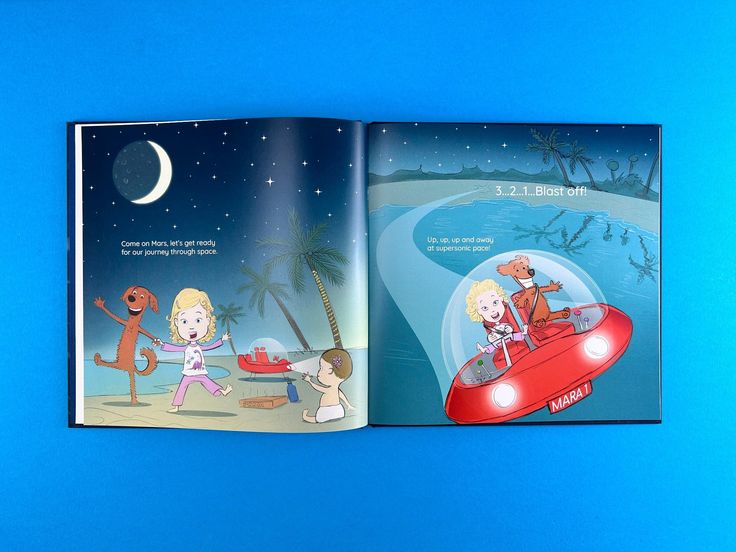
For a children’s book, formatting and interior design are just as important as the story itself. A well-structured layout keeps young readers engaged and makes the text easy to follow.
Typesetting—how text and images are arranged on the page—plays a big role in creating a smooth reading experience. Using tools like Adobe InDesign and Photoshop helps ensure a polished, professional look. When done right, formatting makes your book stand out, drawing in both kids and parents. After all, a well-designed book isn’t just read—it’s experienced!
Printing and distribution costs depend on factors like printing method and quantity. Print-on-demand (IngramSpark) keeps upfront costs low, while offset printing is cheaper for large runs. Bulk orders can cut shipping costs, and distribution platforms take a fee or commission.
If you're an author looking for a cost-effective way to print your book, Ex Why Zed is an excellent option. Whether you’re self-publishing or printing copies for an event, we offer high-quality printing at competitive prices.
Our services are designed to give authors flexibility, whether you need a small batch of books or a larger print run. We focus on excellent print quality, professional finishes, and affordability, ensuring your book looks exactly how you envisioned it.
Want to know how much it will cost? Contact us for a personalized quote! We’ll work with you to find the best printing solution for your budget.
Print on demand (POD) and offset printing are two common methods for producing children's books. Offset printing, ideal for large print runs, offers cost efficiency but requires higher initial investments of several dollars.
In contrast, print on demand (POD) allows for smaller quantities, reducing upfront costs and minimizing inventory storage. However, per-unit costs tend to be higher with print on demand. Understanding the differences between these printing options is crucial in determining the most cost-effective approach for publishing children's books. Make an informed decision based on your budget and publishing goals.
When considering distribution platforms for children's books, choosing ones that cater specifically to younger audiences is crucial. Platforms like Amazon Kindle Direct Publishing (KDP) and IngramSpark are popular due to their reach and ease of use.
KDP allows for easy eBook distribution, while IngramSpark offers a broader reach for standard distribution to traditional bookstores and assists authors in connecting with a traditional publisher. Selecting the right platform can significantly impact the visibility and success of your children's book.
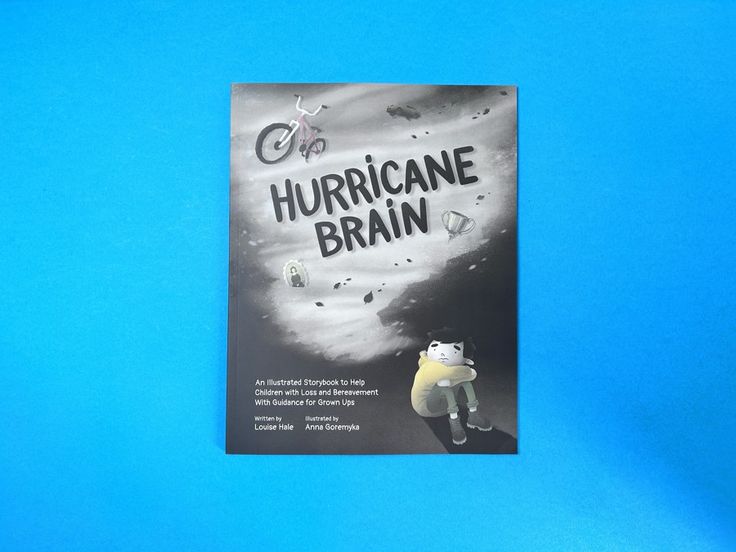
Quality illustrations are essential for children's books, and costs vary depending on the illustrator's experience, style, and timeline. Researching portfolios, seeking referrals, and exploring platforms like Fiverr can help you find the right illustrator within your budget.
Illustration costs for children's books can vary based on several key factors. Understanding these can help you budget effectively while maintaining a balance between quality and affordability. Key factors influencing illustration costs:
Complexity of artwork – Intricate or highly detailed illustrations may have higher fees.
Illustrator’s experience and reputation – Established freelancers and illustrators with strong portfolios typically charge more.
Project timeline – Tight deadlines may lead to additional rush fees.
Specialized skills – Unique styles or techniques may increase costs.
Making informed decisions about these factors ensures you get quality illustrations within your budget.
Finding the right illustrator can make all the difference in bringing your children's book to life.
Start by exploring their artistic style and past experience with children's books to see if they align with your vision.
Check their portfolio to ensure their work fits your story’s tone.
Clear communication is key—make sure they understand your ideas and can meet deadlines.
Be upfront about your budget and negotiate a fair rate.
A strong collaboration with your illustrator will lead to a beautifully illustrated book that truly connects with young readers.
Want to create a visually stunning children's book? Our informative video guide walks you through the entire printing process—from choosing the right size, paper, and binding to exploring winning design styles used by top illustrators. Plus, get insights from iconic children's books that have stood the test of time. In a competitive market, ExWhyZed helps your book stand out and become a favorite on every child’s bookshelf!
Using social media and in-person events like book signings can create buzz for your children's book. Collaborating with bloggers and reviewers further boosts visibility and engagement.
We also provide the perfect avenue for distributing children's books and help spread the word about them on social media. And now, with Ex Why Zed's Book Promotion Social Media Pack, you can take your book launch to the next level!
What's included, you ask?
A professionally crafted press release and blog post to announce your book launch.
A one-week social media calendar to organize your promotional activities.
A month-long social media planner with ideas to maintain momentum.
Social media post suggestions and content ideas for Facebook, Instagram, Threads, X (Twitter), TikTok, LinkedIn, Pinterest, YouTube, and blogs.
A collection of 10-20 high-quality photos of your finished book.
A one-minute landscape flick-through video for YouTube, Facebook, Instagram Grid, and blog posts.
A one-minute portrait flick-through video for YouTube Shorts, TikTok, Instagram Reels and Stories, Threads, Facebook Stories, X (Twitter), and mobile sharing.
An online flipbook of your book for easy sharing and previewing.This packed set of resources allows you to start promoting your book immediately across multiple channels—without the heavy lifting. Simply copy them into your Posts, Feed, Stories, and Blogs, and let the world see what you've created.
Engaging directly with your audience through in-person events and school visits can significantly boost the visibility and sales of your children’s book. These interactions offer a personal touch, connecting you with young readers and decision-makers.
Organizing book readings, signings, or workshops can create a memorable experience for children, parents, and educators, fostering a loyal readership. Collaborating with schools for author visits can also generate word-of-mouth buzz and establish credibility within the educational community. Maximize these opportunities to forge valuable connections and enhance your book's presence.
Want to get your children's book in front of more readers? Connecting with book bloggers and reviewers is a great way to boost visibility! Start by reaching out with a personalized pitch—highlight what makes your book special and why their audience would love it.
Focus on bloggers who cover children's books or parenting topics to reach the right readers. Offering review copies or running giveaways can help generate buzz and excitement. Positive reviews build credibility and attract more buyers. Just remember, building relationships takes time, but a solid connection with the right influencers can lead to long-term success!
At ExWhyZed, we turn your stories into beautifully printed children's books with stunning colors, durable materials, and professional finishes—right here in the UK. Whether you're a self-publishing author or an independent publisher, we make the process seamless with expert guidance, eco-friendly printing options, and fast turnaround times. To enhance your publishing experience, consider using the Reedsy Book Editor to create a book that captivates young readers and stands out on the shelf! Get a free quote now!
Publishing a children's book involves various costs such as manuscript editing, illustration, formatting, printing (including options like paperback), and distribution. Hiring a professional illustrator can significantly impact your budget. Factors like the length of your book, illustrator experience, and complexity of illustrations influence pricing. Tips for hiring include reviewing portfolios and discussing project specifics. Printing costs vary based on print on demand or offset printing. Distribute through platforms like Amazon and IngramSpark. Marketing strategies like social media, in-person events, and collaborations are crucial for promoting your book effectively.
Consider key factors like target age group, illustration style, printing options, and marketing strategy. Ensure the book aligns with children's interests and preferences. Attention to detail in editing, design, and distribution is crucial for a successful children's book launch.
To self-publish a children's book, costs can vary. Expenses include editing, illustrations, formatting, printer services, and cover design, distribution. On average, total expenses may range from $1,000 to $10,000 or more depending on the quality and services chosen.
Earnings from children's books vary based on sales, royalties, and deals. Success can lead to substantial income through book sales, merchandise, and adaptations, especially when using strategies like Amazon ads. Factors such as marketing efforts and audience engagement play a crucial role.
Self-publishing a children's book can cost anywhere from $1,500 to $10,000+, with the average cost depending on expenses like editing, illustration, design, printing, and marketing. This comprehensive guide to self-publishing highlights that the biggest costs are typically illustrations and printing, which vary based on quality and distribution choices.
An informative 5 minute read.
At Ex Why Zed, children’s book printing is more than just a technical service—it’s a deeply creative endeavour that merges imaginative storytelling with expert craftsmanship. Whether you’re an author, illustrator, or an independent creator looking to self publish a book, each children’s title that comes through our doors is treated with care and precision. We understand that printing a children’s book isn’t merely about getting ink on paper; it’s about building stories that captivate, educate, and endure.
To help you make informed print choices when you self publish a book, we’ve analysed and dissected a series of recent children’s book printing projects. Across hardbacks, paperbacks, and stapled booklets, our goal is to showcase the breadth of printing possibilities and the winning design decisions that can transform a manuscript and illustrations into a truly impactful reader experience. Below, you’ll find detailed insights into each project, complete with the nuances that made them shine.

Read our Children's Book printing series case study here
The “Where Are You Going Today?” series—featuring Summer Tractor, Christmas Tractor, and Excavator—exemplifies clever print design anchored in a perfect bound children’s book format. Each title taps into distinct seasonal themes, which keeps audiences returning year after year. Beyond the appealing illustrations, the standout choice was a landscape orientation and a gloss-laminated cover—both decisions that instantly evoke a sense of quality while protecting against spills and sticky fingers. Inside, uncoated text pages make the colours appear soft and inviting, perfectly suited to a younger readership.
Crucially, the binding depth and page layout were designed to accommodate large, playful illustrations without overwhelming the text. Bright imagery paired with clean, readable typography keeps the storyline engaging for children. This series is also a testament to how seasonal hooks can foster ongoing reader curiosity. As summer blends into winter festivities and back to everyday adventure, the print choices—like gloss-laminated covers—ensure each book remains sturdy through repeated reads, while the uncoated stock inside gives parents and children a tactile reading experience.
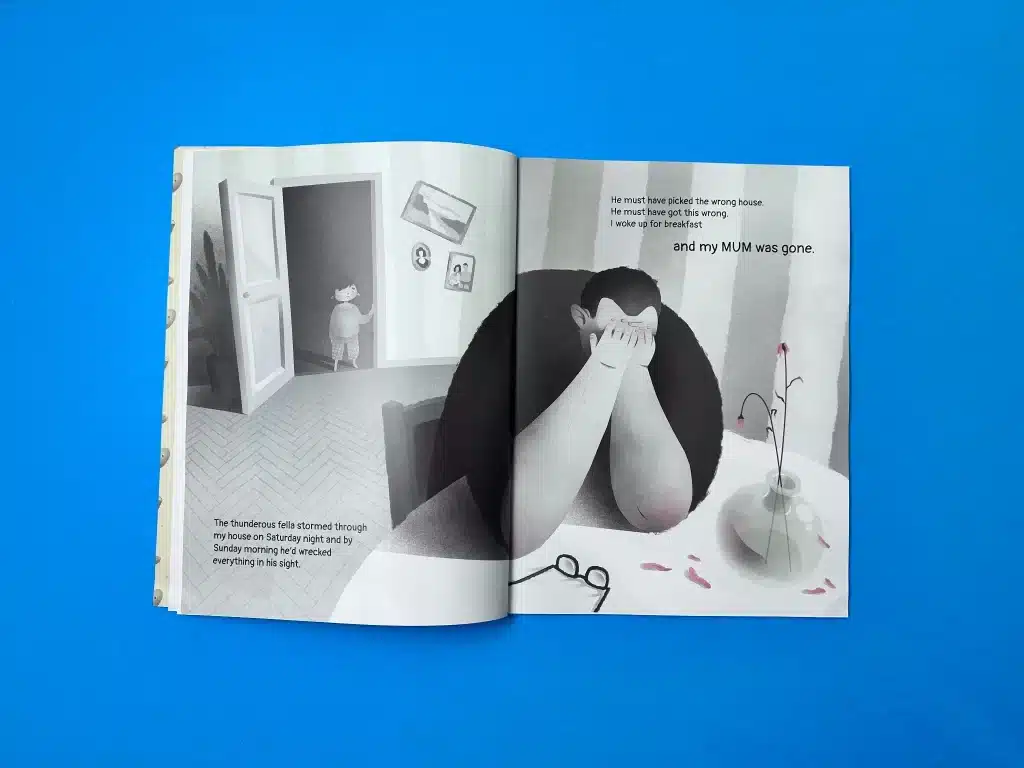
Read the full Hurricane Brain case study here
Hurricane Brain tackles a sensitive subject—loss and bereavement—through a thoughtful blend of emotive artwork and carefully chosen finishes. Opting for a perfect bound children’s book gave the project a polished feel, enhanced by a softly textured matt lamination on the cover that gently sets the book’s gentle, contemplative tone. Inside, uncoated paper stock was used to bring depth and warmth to the subdued colour palette, mirroring the emotional weight of the storyline. This design choice allowed the illustrations and text to breathe, showing sensitivity to the book’s difficult theme.
The print specification intentionally centred on user experience. Wider margins around the text and ample white space were incorporated to ensure the layout felt calming and not visually overwhelming for a child dealing with grief. The interior spreads underscore how a carefully balanced approach—e.g., combining child-friendly typography with earnest, hand-drawn images—can help children process heavy topics. The production approach demonstrates how an empathetic design and finishing method can be instrumental in creating books that guide readers through challenging emotional journeys.
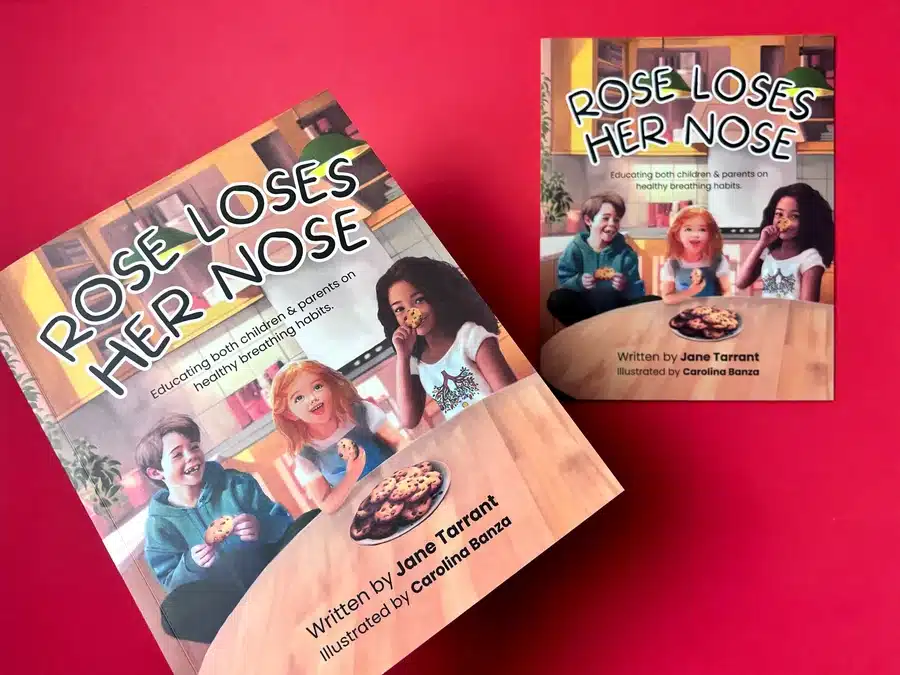
Read the full Rose Loses Her Nose case study here
“Rose Loses Her Nose” captures the quintessential heart of a self-published children’s book by balancing budget considerations with a polished outcome. The client chose a heavier cover stock to give the book a sturdy, “grown-up” feel while retaining lighter silk pages inside, ensuring the overall weight remained manageable. This thoughtful binding decision gave the story a real sense of identity—it feels more like a treasured keepsake than a flimsy booklet.
The print design pivots around child-friendly illustrations and typefaces that exude warmth. The covers were colour-matched meticulously to maintain vibrancy, a vital detail that ensures the titular “nose” stands out among the pastel backgrounds. Meanwhile, perfect binding accommodates enough pages to showcase large illustrations alongside the text without compromising structural integrity. The result is a cherished children’s book that looks and feels professional, effectively dispelling any preconceived notions about self-publish quality.
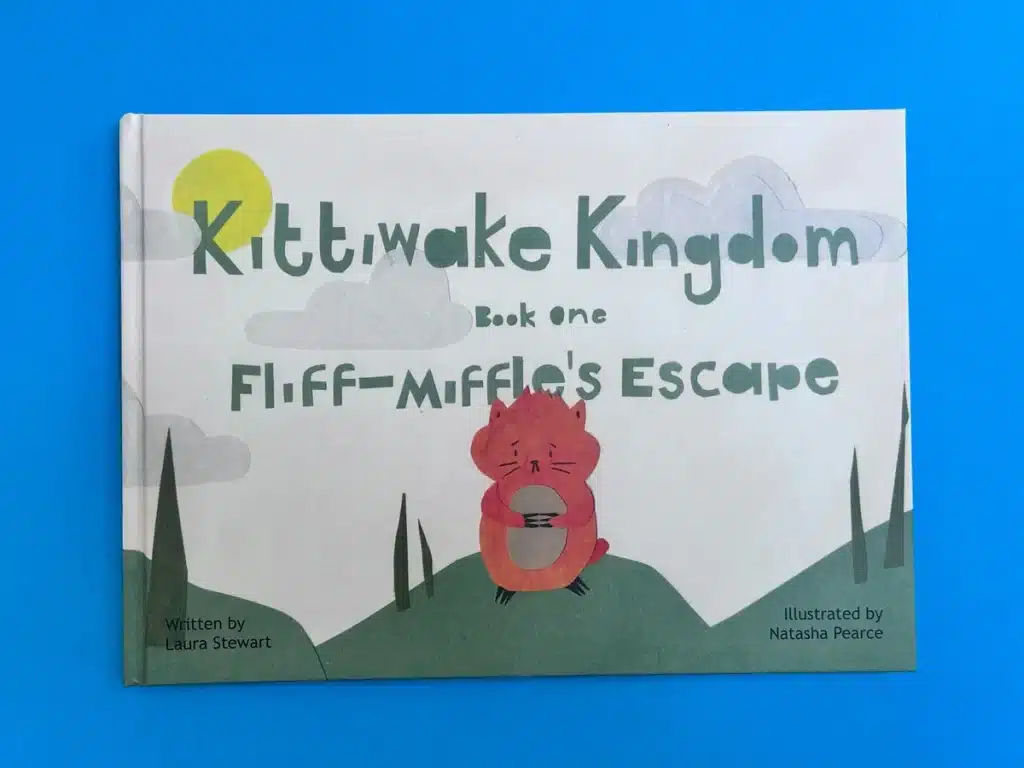
Read our Kittiwake Kingdom case study here
“Kittiwake Kingdom: Fliff-Miffle’s Escape” is a prime example of how going the extra mile with a casebound solution can generate a strong “wow” factor. By wrapping a vibrant cover illustration around greyboard and finishing it with matt lamination, this project immediately stands out on the shelf. The decision to include 4pp printed endpapers further enhances the sense of immersion. Upon opening, readers are greeted with thematic designs that hint at the story’s whimsical realm—a triumph of cohesive, thorough design.
Inside, the choice of uncoated paper adds textural depth, which, in turn, intensifies the colours of the lively illustrations. This format gives readers a tangible connection to the magical world, while the robust binding ensures the book can handle repeated reading without wear. By merging attractive casebound engineering with meticulous artistic vision, the creators of “Kittiwake Kingdom” have turned a children’s story into something bordering on collector’s-item quality—demonstrating how premium materials can elevate a project to new heights.
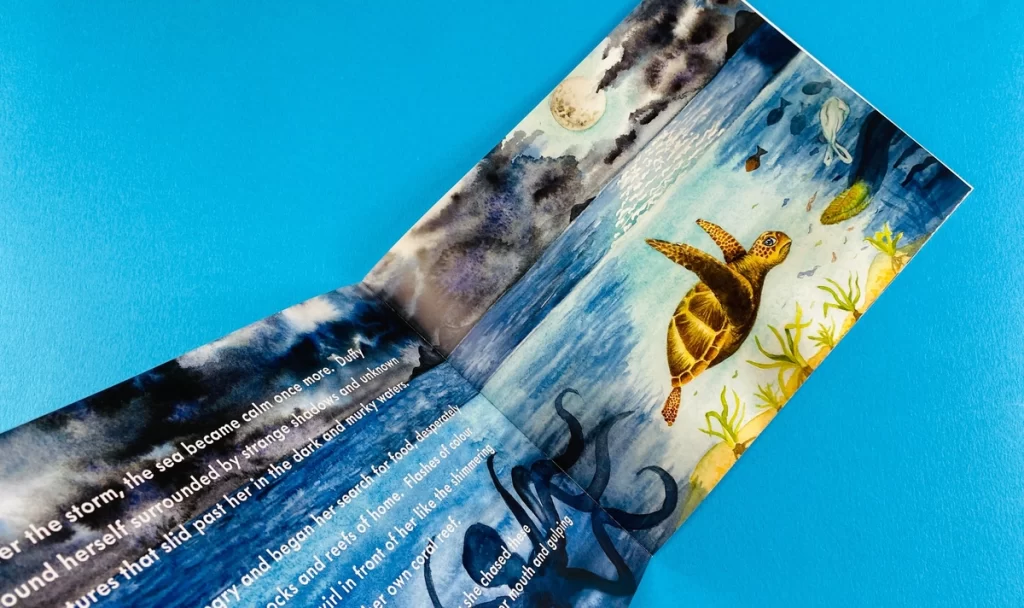
Read the inspiring Duffy The Sea Turtle case study here
“Duffy’s Lucky Escape” stands out for its stapled children’s book printing approach (wire-stitched binding), reinforcing that litho printed booklets look polished and impactful. The author made the clever decision to apply gloss lamination just to the cover’s exterior, creating an appealing shine that reflects underwater light for their sea turtle tale. Internally, a silk paper finish provides clarity to the oceanic colour scheme, allowing each page to pop with aquatic life and environmental messaging.
This booklet has secured national publicity, not just for its engaging narrative but also for its durable, kid-friendly format. Wire-stitched spines are a great fit for stories under 40 pages, particularly when you want to keep costs manageable without sacrificing quality. The vivid artwork connects with children on an emotional level, and the straightforward, staple-bound structure ensures easy page turns—crucial for school readings and environmental awareness campaigns. Overall, the design underscores how short, focused children’s books can remain visually compelling.
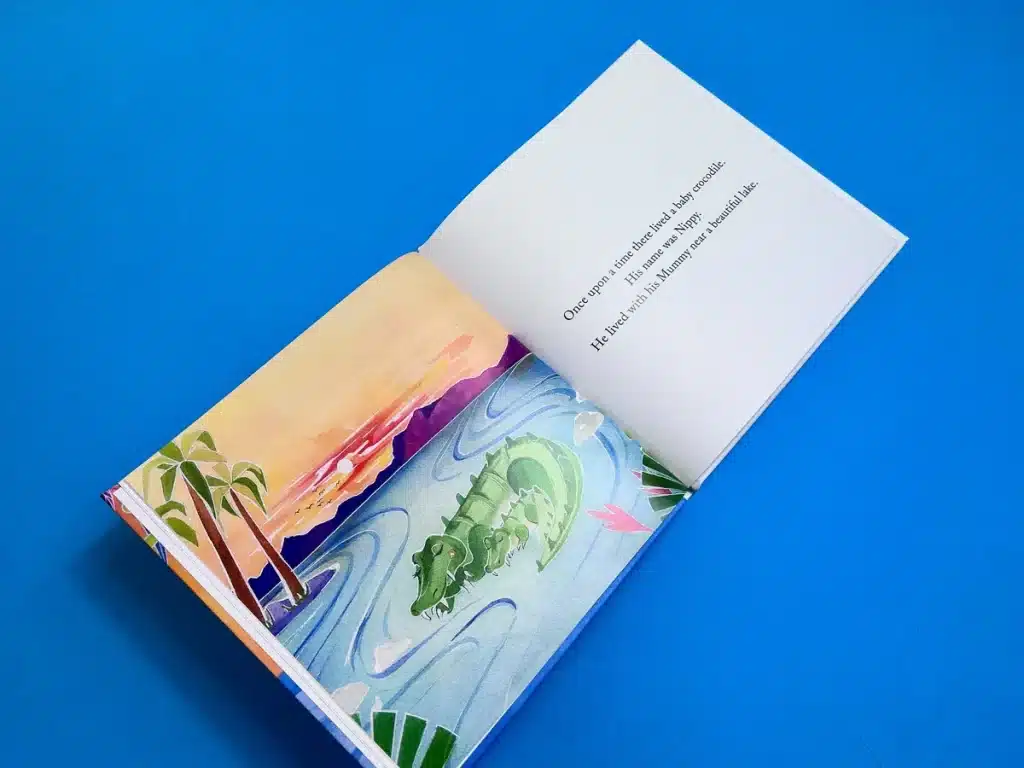
Read our Nippy The Baby Crocodile case study here
“Nippy the Baby Crocodile” takes the durability of a hardback design to heart, combining 170gsm silk pages with a matt-laminated cover for a sturdy yet inviting tactile experience. This choice was essential for a children’s story about an adventurous crocodile, as it ensures the book remains in prime condition despite rough-and-tumble usage by little hands. The thick greyboard spine supports the integrity of the binding, reinforcing the book’s premium feel.
Inside, the cohesive visual identity is carried by animated watercolour illustrations, each emphasised by a slightly glossy sheen on the silk pages. The carefully balanced text-to-illustration ratio keeps readers engaged, while easy-to-read fonts cater to younger audiences. The author’s decision to go casebound underscores the book’s lasting value—an ideal approach for authors who want to communicate that their titles are meant to be treasured for years to come.
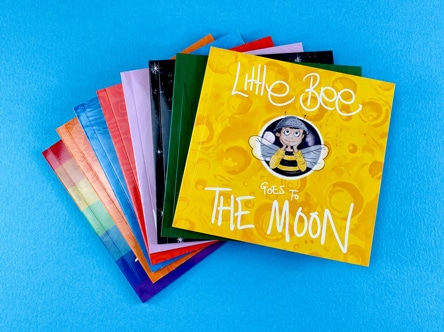
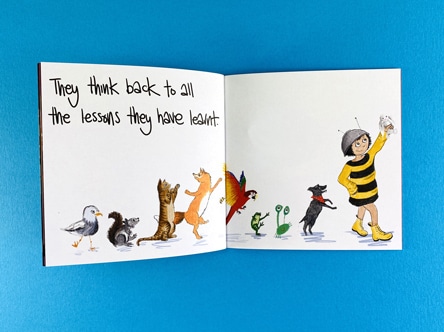
Read more about the Little Bee series of reading books here
“The Fascinating Adventures of Little Bee” is a vibrant mix of music, rhyme, and story spread across ten titles, each with its own cover design. This project shows how a self-published series can remain cohesive while giving each instalment a distinct look. By choosing a smaller, square format (148×153mm), the creator gave each book a unique footprint, lending a collectable charm. The silk covers pop with colour, while the uncoated text pages maintain a pleasant grip that kids love.
Perfect binding these slender volumes underscores their standalone appeal while still presenting them as a set. The synergy of music, rhyme, and energetic visuals demands high-quality print reproduction—something that was achieved by meticulously calibrating vibrant inks. Each cover’s individually themed artwork helps distinguish the separate adventures while supporting brand identity across all ten titles. This clever combo of multiple covers, accessible design, and robust binding showcases the boundless creativity possible within children’s book printing.
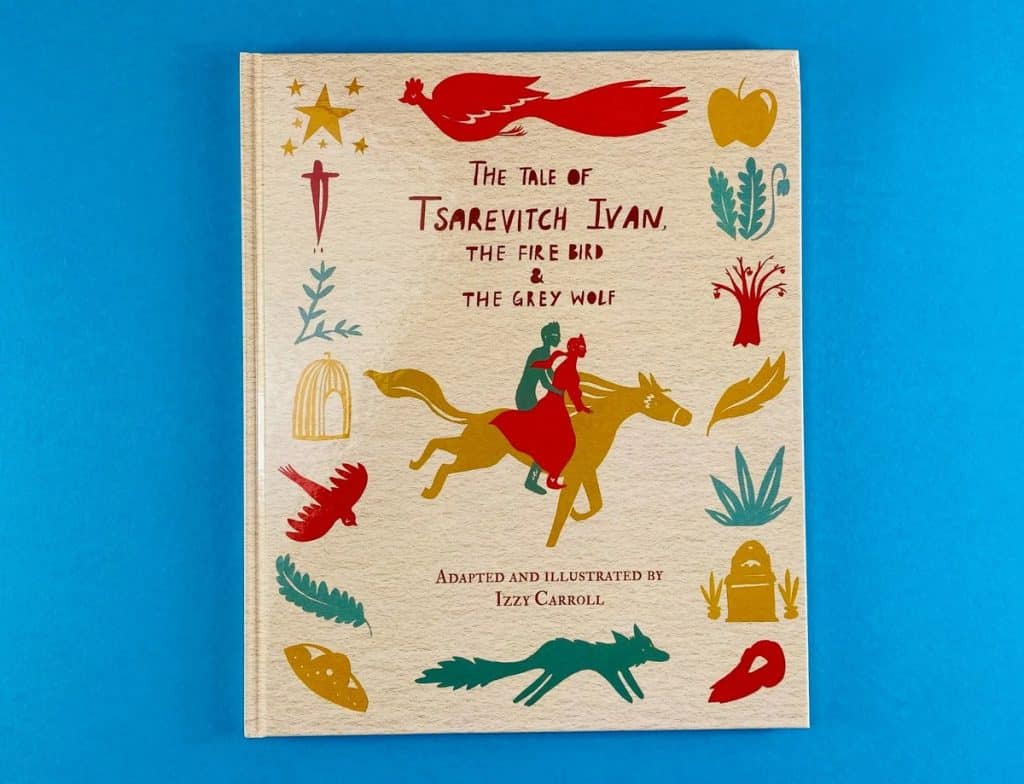
This folklore-inspired title merges modern aesthetics with traditional Slavic motifs, demonstrating how cultural narratives can receive fresh visual life. The matt-laminated casebound design offers a satisfying heft, highlighting the depth and intricacy of the illustrations. Uncoated endpapers introduce the reader to silhouettes of the Fire Bird and Wolf right from the start—an impactful nod to the story’s mythical elements.
Inside, rich, textured visuals leap off the pages thanks to thoughtful colour control during production. Striking reds and golds dominate, balanced by a cream background, so the text remains legible without undermining the artwork. By harmonising folklore motifs with contemporary layout structures, this project proves that timeless tales can connect with modern audiences—especially when anchored by purposeful print choices like premium binding and quality paper stocks.
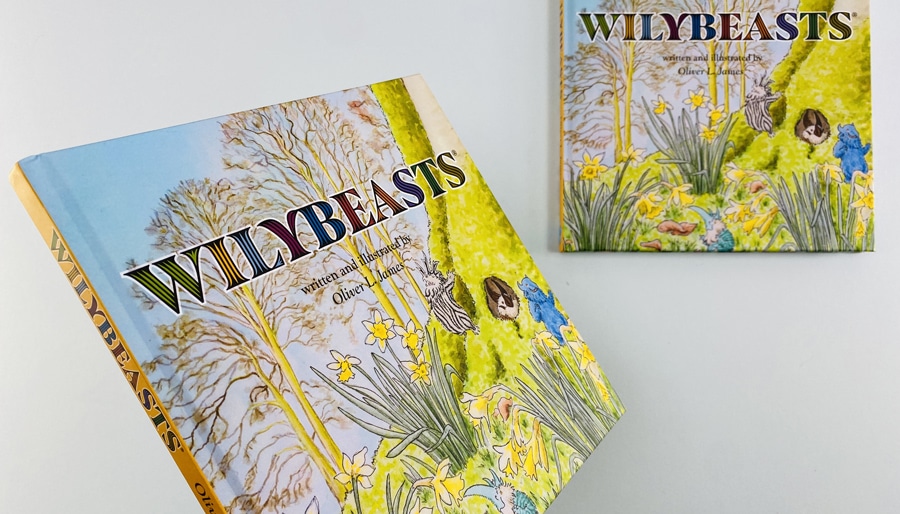
“Wily Beasts” expertly leverages a 210×210mm casebound format to house vividly drawn animals and whimsical storylines. One of its key design triumphs is the fully utilised hardcover, allowing high-impact illustrations on the front, back, and spine, with printed endpapers adding a theatrical opening sequence for the reader. This sense of continuity from cover to endpapers fosters an instant engagement, as though stepping into a richly imagined world.
Opting for sturdy greyboard covered in silk-finish paper and topped with a matte laminate ensures each page turn is an immersive, uninterrupted experience. The 9mm spine also supports a heftier page count, ideal for in-depth storytelling. By integrating colour bursts and imaginative typography, the design encourages young readers to linger on each spread. Taken together, these decisions yield a polished, stand-out children’s book perfect for authors or illustrators who see their creations as enduring art pieces.
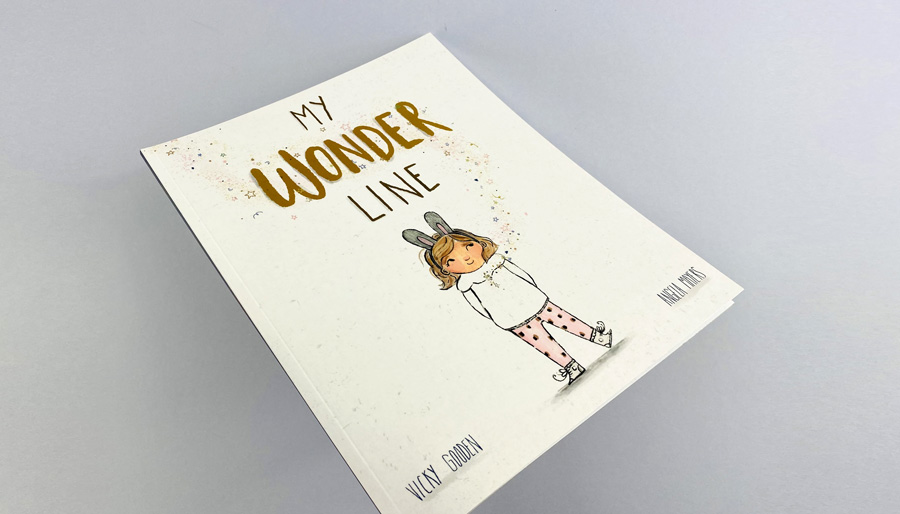
Read the heart warming case study of My Wonder Line here
“My Wonder Line” offers an uplifting message of self-acceptance for children who have scars, achieved through a visually gentle yet striking design. The 265×210mm format—a comfortable middle ground between A5 and A4—ensures broad, bright illustrations can shine without making the book cumbersome for small hands. A silk cover packs in vibrant colours, while the uncoated interior pages add a comforting texture that feels just right for delicate subject matter.
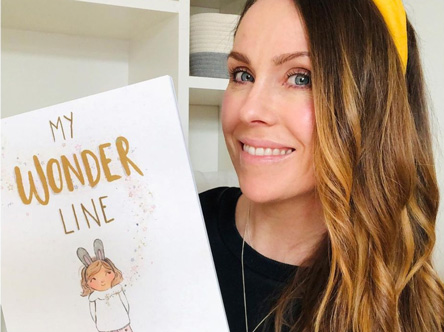
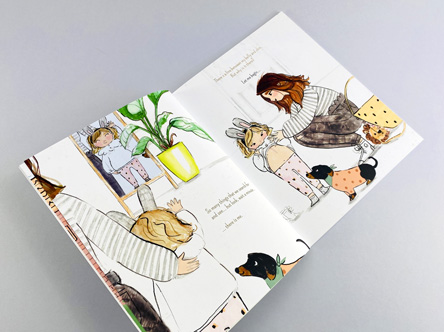
Central to the book’s visual impact is how seamlessly the text floats alongside the beautiful illustrations by Angela Mayers. The choice of a perfect-bound spine maintains a clean profile, and the short-run printing format accommodates a heartfelt story of roughly 32 pages. It’s proof that meaningful narratives can be underscored by equally thoughtful print production, reinforcing a message of hope and representation for children everywhere.

“Mars and Mara Explore The Stars” embraces an impressive square 230×230mm children’s book printing style, emphasising large, full-bleed space illustrations. The binding choice—a sturdy, casebound finish—supports the book’s adventurous theme, allowing cosmic backdrops to flow across double-page spreads without disruption. The heavy greyboard interior, wrapped in a matt-laminated cover, feels premium and appealingly robust in young hands.
Inside, deep blues and bright oranges form a visually powerful contrast that underscores the journey through distant planets. Generous margins on text sections guarantee readability, while the vibrant images command centre stage. The creative team’s choice to include printing on the endpapers further immerses readers, hinting at star-filled exploration from the moment the cover is lifted. Overall, it’s a model example of how thoughtful design choices—from page size to paper weight—can support and elevate a thematic narrative.
If you’re keen to self publish a children’s book or explore different binding and finishing options—like perfect bound children’s books or stapled children’s book printing—we’re here to help. Our passion is transforming imaginative stories into tangible, page-turning adventures.
Contact us today to embark on your own children’s book printing journey with Ex Why Zed. Let’s turn your ideas into enchanting books that readers will treasure for years to come.
Let Ex Why Zed handle your book fulfilment, storage, and distribution! Click to read more.

